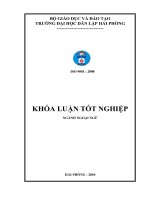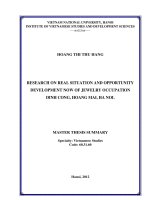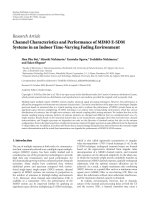Research on clinical characteristics and hs-CRP, procalcitonin, interleukine 6 in children under 5 years old with severe viral pneumonia and Co-infection
Bạn đang xem bản rút gọn của tài liệu. Xem và tải ngay bản đầy đủ của tài liệu tại đây (97.16 KB, 8 trang )
Journal of military pharmaco-medicine no8-2019
RESEARCH ON CLINICAL CHARACTERISTICS AND hs-CRP,
PROCALCITONIN, INTERLEUKINE-6 IN CHILDREN UNDER
5 YEARS OLD WITH SEVERE VIRAL PNEUMONIA
AND CO-INFECTION
Nguyen Thi Ngoc Tran1; Do Quyet2; Dao Minh Tuan1
SUMMARY
Objectives: To describe clinical characteristics and hs-CRP, procalcitonin, interleukinee-6 of
severe viral pneumonia and co-infection with other viruses or/and bacteria among children
under 5 years old at National Hospital of Pediatrics from January, 2015 to March, 2017.
Subjects and methods: Descriptive, cross-sectional study on 53 children under 5 years old were
diagnosed with severe viral pneumonia co-infection with other viruses or/and bacteria. Results:
Pneumonia caused by syncytial respiratory virus in 14 patients (26.4%), influenza A in 13
patients (24.5%), Adenovirus in 12 patients (22.6%), Rhinovirus in 10 patients (18.9%) and
influenza B in 4 patients (7.6%). Children could be co-infected with other viruses or/and
bacteria. Haemophilus influenza co-infection rate was the highest (19 patients = 45.2%),
followed by Klebsiella pneumoniae and Pseudomonas aeruginosa (19.1%). The lowest rate of
bacterial co-infection was Burkholderia cepacia and Staphylococcus aureus (1 case = 2.4%). In
the bacterial co-infection group, rate of cyanosis was the lowest (20.6%); the highest rate of
cyanosis was in the group of viral-bacterial co-infections (100.0%). The difference between
three groups was significant (p < 0.05). There was no difference in other clinical characteristics
and hs-CRP, procalcitonin, interleukine-6 among three groups (p > 0.05). Conclusion: The
incidence of children with pneumonia had co-infection in syncytial respiratory virus group was
the highest. Children could be co-infected with other viruses or/and bacteria. Haemophilus
influenza co-infection rate was the highest. The difference of cyanosis between three groups
was significant. There was no difference in other clinical characteristics and hs-CPR,
procalcitonin, interleukine-6 among three groups.
* Keywords: Pneumonia; Co-infection; Children.
INTRODUCTION
In Vietnam, on average, children get
acute respiratory infections from 3 - 5 times
every year, including 1 - 2 times of
pneumonia [1]. The number of children
with pneumonia accounts for 30 - 40% of
cases of examination and treatment in
hospitals. Death rate of pneumonia accounts
for 75% of death cases from respiratory
diseases and 30 - 35% of death cases
1. National Hospital of Pediatrics
2. Vietnam Military Medical University
Corresponding author: Nguyen Thi Ngoc Tran ()
Date received: 04/09/2019
Date accepted: 11/10/2019
173
Journal of military pharmaco-medicine no8-2019
among children [1]. The incidence of viral
pneumonia is quite high, accounting for
60 - 70% [1]. Common viruses that cause
pneumonia are syncytial respiratory virus
(RSV), influenza, Rhinovirus, Adenovirus
[5]. More than one-third of cases of viral
and bacterial co-infection aggravate the
disease [6, 7].
Currently, the viral diagnostic method
has many advantages to help identify the
cause quickly and accurately such as fast
antigen detection test, real-time PCR and
multi-primed PCR with high sensitivity and
specificity.
The study of factors evaluating severe
conditions such as CRP (as well as
hs-CRP),
procalcitonin
(PCT)
and
cytokines (such as interleukine-1 (IL-1),
IL-6, IL-8, IL-10 and HMGB-1) will facilitate
diagnosis, differential diagnosis (viral and
bacterial infections), prognosis and
appropriate treatment, avoiding misuse
of antibiotic use. Especially, IL-6 exhibits
very specify for acute inflammation.
Up to now, no much studies about
viral pneumonia co-infection and other
inflammation factors in pneumonia due
to co-infection with bacteria and other
viruses in Vietnamese children have been
carried out.
Therefore, we have conducted the
project with aims: To describe the clinical
characteristics and hs-CRP, PCT, IL-6 of
severe viral pneumonia and co-infection
with bacteria and/or other viruses in under
5 years old children at National Hospital
of Pediatrics from January, 2015 to March,
2017.
174
SUBJECTS AND METHODS
1. Subjects.
53 patients under 5 years old, who
were diagnosed with severe viral pneumonia
due to co-infection with bacteria and/or
other viruses, were treated at National
Hospital of Pediatrics from January, 2015
to March, 2017.
* Exclusion criteria:
- Patients were under 1 month of age
and older than 5 years old.
- Patients had non-viral pneumonia
(pneumonia after drowning, chemical
pneumonia, aspiration pneumonia).
- Patients had chronic, associated
congenital diseases (airway malformation,
congenital lung disease, liver failure,
kidney failure...).
- Patients were eligible to participate in
the study but the parents or guardian did
not agree to participate.
2. Methods.
- Study design: Descriptive, crosssectional study.
- Sample size: 53 patients.
* Diagnosis of severe viral pneumonia
with co-infection:
- Diagnosis of pneumonia: Patients were
diagnosed with pneumonia according to
WHO (2013) criteria: Cough or having
difficulty in breathing, rapid breathing,
intercostal muscle external retraction,
cracker, crepitation, X-ray image of
infiltrated parenchyma [4].
- Diagnosis of severe pneumonia: A
child with cough or having difficulty in
breathing, plus at least one of the
following main symptoms: Cyanosis or
Journal of military pharmaco-medicine no8-2019
SpO2 < 90%, severe respiratory failure
(wheezing and severe chest retraction).
Signs of pneumonia with severe general
signs such as not drinking or giving up
or vomitting everything, coma or
unconsciousness, seizures.
- Diagnosis of viral pneumonia with
co-infection: Patients with two or more of
the following tests are positive: Rapid
test of influenza A, B, RSV, RT-PCR
of influenza A, B, RSV, Adenovirus,
Rhinovirus and bacterial culture are
positive in nasopharyngeal fluid test.
* Study techniques:
retraction, nasal flaring, head-bobbing with
each breath, intercostal muscle contraction,
rales in the lungs.
+.Other symptoms: Skin rash,
conjunctivitis, hepatomegaly, vomiting,
diarrhea.
- Subclinical:
+ Index: hs-CRP, PCT, IL-6, PaO2.
+ Rapid test for influenza A, B, RSV;
RT-PCR for Adenovirus, Rhinovirus.
+ Bacterial culture.
* Criteria of evaluation applied in the
study:
- hs-CRP: Normal: ≤ 0.5 mg/dL.
- Clinical symptoms:
+ Systemic symptoms: Temperature,
breathing rate, heart rate, weight, SpO2.
- PCT: Increase: > 0.05 ng/mL; normal:
≤ 0.05 ng/mL.
+ Functional symptoms: Cough, wheezing,
runny nose, vomiting, convulsions.
- IL-6: Unit pg/mL (study).
+ Examination of respiratory entity
symptoms: Difficulty in breathing, chest
- Microbiological test: Negative or positive.
- PaO2: Normal 70 - 99 mmHg.
* Data analysis: By STATA 14.0 software.
RESULTS
During the study period from January, 2015 to March, 2017, there were 53 patients
with viral pneumonia co-infected with bacteria and/or viruses.
Table 1: Characteristics of microbiology (n = 53).
1
baterium
2
bacteria
3
bacteria
1
virus
1 baterium
+ 1 virus
1 bacterium +
2 viruses
n
n
n
n
n
n
RSV (n = 14)
8
2
1
2
1
0
Influenza A (n = 13)
5
0
0
6
0
2
Adenovirus (n = 12)
6
0
1
3
2
0
Rhinovirus (n = 10)
7
0
0
0
3
0
Influenza B (n = 4)
4
0
0
0
0
0
Virus
Among 14 children with RSV co-infection, 8 cases infected only 1 bacterium. In 13
children with influenza A infection, 6 children infected with 1 virus. In the groups of
children with Adenovirus, Rhinovirus and influenza B, the majority number of children
were infected with only 1 bacterium.
175
Journal of military pharmaco-medicine no8-2019
Table 2: Charateristics of bacterial co-infection (n* = 42).
Patients with each
type of bacteria
(n = 48)
Percentage of
co-infected patients
(%)
Percentage of all
patients (%)
Haemophilus influenza
19
45.2
9.4
Klebsiella pneumoniae
8
19.1
4.0
Pseudomonas aeruginosa
8
19.1
4.0
Streptococcus pneumoniae
7
16.7
3.5
Acinetobacter baumannii
4
9.5
2.0
Burkholderia cepacia
1
2.4
0.5
Staphylococcus aureus
1
2.4
0.5
Bacterial co-infection
(*n: Number of patients with severe viral pneumonia co-infection)
The highest incidence was Haemophilus influenza co-infection (45.2%), followed by
Klebsiella pneumoniae and Pseudomonas aeruginosa (19.1%). The lowest incidences
were Burkholderia cepacia and Staphylococcus aureus (1 case = 2.4%).
Table 3: Clinical characteristics of patients with co-infected pneumonia (n = 53).
Co-infection
Bacteria
(n = 34)
Symptoms
Systemic
Respiratory
Others
Bacteria +
virus (n = 8)
p
n
%
n
%
n
%
Fever
30
88.2
10
90.9
6
75.0
0.51**
Tachycardia
20
58.8
10
90.9
4
50.0
0.10**
Runny nose
14
41.2
4
36.4
1
12.5
0.38*
Wheezing
29
85.3
9
81.8
6
75.0
0.76*
Grunting
1
2.9
2
18.2
2
25.0
0.06*
Poor feeding
23
67.6
10
90.9
8
100.0
0.08*
Not feeding
2
5.9
1
9.1
1
12.5
0.78*
Not drinking
2
5.9
1
9.1
1
12.5
0.78*
Irritating and crying
11
32.4
1
9.1
4
50.0
0.17*
Convulsions
0
0.0
1
9.1
1
12.5
0.12*
Cyanosis
7
20.6
5
45.5
8
100.0
< 0.01*
Diarrhea
11
32.3
1
9.1
1
12.5
0.33*
Hepato-splenomegaly
4
11.8
3
27.3
3
37.5
0.15*
Skin rash
1
2.9
2
18.2
1
12.5
0.13*
(*: Fisher’s exact test)
176
Virus
(n = 11)
Journal of military pharmaco-medicine no8-2019
Among the co-infection groups, the cyanosis rate was the lowest with 20.6%. The
highest incidence was found in the co-infection with bacteria and viruses (100.0%). The
difference between three groups was significant (p < 0.05). There was no difference in
other characteristics among three groups (p > 0.05).
Table 4: Characteristics of respiratory failure in co-infected pneumonia patients (n = 53).
Co-infection
Bacteria
(n = 34)
Characteristics
SpO2
PaO2
Virus
(n = 11)
Bacteria +
virus (n = 8)
n
%
n
%
n
%
Grade 1 (SpO2 90 - 95%)
22
64.7
5
45.5
3
37.5
Grade 2 (SpO2 85 - 90%)
9
26.5
3
27.3
2
25.0
Grade (SpO2 < 85%)
3
8.8
3
27.3
3
37.5
Normal
11
32.4
3
27.3
4
50.0
Mild respiratory failure
14
41.2
3
27.3
3
37.5
Moderate respiratory failure
6
17.6
2
18.2
0
0.0
Severe respiratory failure
3
8.8
3
27.3
1
12.5
p
0.23*
0.61*
(*: Fisher’s exact test)
There was no difference in respiratory failure groups among three groups (p > 0.05).
Table 5: Subclinical characteristics in co-infected pneumonia patients (n = 53).
Co-infection
Index
Bacteria (n = 34)
th
Median
25 - 75
hs-CRP (mg/dL)
12.7
PCT (ng/mL)
IL-6 (pg/mL)
Virus (n = 11)
th
th
Median
25 - 75
2.4; 50.2
4.1
2.3
0.2; 4
5.4
3.4; 16.3
Bacteria + virus (n = 8)
th
th
p
th
Median
25 - 75
0.3; 8.2
4.0
2.1;17.9
0.13*
0.4
0.2; 1
1.0
0.4; 3.6
0.19*
10.6
5.2; 21.1
24.8
7.7; 91.1
0.39*
(*: Kruska-Wallis test)
hs-CRP had the fastest increase in the co-infection group (median = 12.7), followed
by the co-infection with virus group (median = 4.1), co-infection with viruses and
bacteria (median = 4.0). Similarly, PCT had the highest increase in the co-infection
group only (median = 2.3), followed by the co-infection with viruses and bacteria
(median = 1.0), the lowest one was in the co-infection group with virus only (median = 0.4).
IL-6 had the highest one in the co-infection group with both virus and bacteria
(median = 24.8), followed by the co-infection group with virus only (median = 10.6), the
lowest increase was in the co-infection group with bacteria (median = 5.4). However, all
differences were not significant (p > 0.05).
177
Journal of military pharmaco-medicine no8-2019
DISCUSSION
1. Characteristics of
viral-bacterial infection.
co-infected
Childhood viral pneumonia is a
common illness, with an incidence of
36 - 40 episodes/1,000 children/year in
those < 5 years old. The concomitant
viral-bacterial infection can cause the
severe pneumonia in children. O'Brien K.L
(2000) determined that preceding
influenza infection (H1N1) was directly
associated with pneumococcal illness in
children. [8]. Juven had shown that more
than one-half of all community-acquired
pneumonia were infected with bacteria
and viruses [9].
In this study, in 14 patients with RSV
infection, 8 patients had co-infection with
1 bacterium. In 13 children with influenza
A infection, 6 children were infected with
1 virus. In the groups infected with
Adenovirus, Rhinovirus and influenza B,
the majority number of children had only 1
bacterial co-infection. The results also
showed that the incidence of Haemophilus
influenza was the highest (45.2%),
Klebsiella pneumoniae and Pseudomonas
aeruginosa 19.1%. The lowest incidences
were in Burkholderia cepacia and
Staphylococcus aureus (1 case). In
addition, in the RSV infective group, there
were 3 cases of co-infection with two or
more bacteria and 1 case of co-infection
with one type of virus and one type of
bacteria. Meanwhile, in Adenovirus
infective group, the number of infected
children were 1 and 2 cases, respectively.
Comparing with the Andrew’s study
(2001), it was found that, in 58 patients
178
who identified the cause of pneumonia,
65% of patients infected with 1 virus, 35%
were co-infected [10].
In a recent study by Nascimento et al
(2013) on 25 children with pneumonia
having pleural effusion showed that 22%
of cases of co-infection with bacteria
and virus, of which co-infection with
parainfluenza 1/3 and influenza A, RSV
and influenza A were common [11]. Juven
(2000) found evidence of viral-bacterial
infection in 30% of the children with
pneumonia, a result which was in
agreement with previous studies [9].
According to study by Olli Ruuskanen,
49% of pneumonia cases in the study
group were viral infected, of which the
number of children infected with Rhinovirus
was the highest at 18%, RSV was 16%,
influenza A was 9 %, influenza B and
Adenovirus were 8% [6].
Li Li et al (2016) studied 1,702 children
with lower respiratory tract infection, the
co-infection rate among Rhinovirus-type C
group was 61% [12].
Research by Dao Minh Tuan and
Nguyen Thi Ngoc Tran on 56 children with
Adenovirus pneumonia showed that
patients could be co-infected with 1 virus
and other bacteria (16/56 children with
Rhinovirus, 14 with CMV, 2 with RSV), 2
infected with influenza A, influenza B, 10
infected with bacteria, 3 infected with
Mycoplasma) [2].
Children with broncho-pneumonia
infected with Adenovirus had a high rate
of co-infection. Rhinovirus was the highest
co-infection, the second was CMV
co-infection, the third was bacterial
co-infection. This showed the importance
Journal of military pharmaco-medicine no8-2019
of isolating children, not only avoiding the
spread of Adenovirus to other children but
also helping them to avoid new infections
[2].
Tran Thi Thuy's study showed that
Adenovirus pneumonia patients had 9.0%
of bacterial co-infection: 3 cases of
pneumococcal infection, 2 cases of
Haemophilus influenza infection, 1 case
of Moracela catarhalis infection. There
were 28.0% of cases with virus co-infection:
mainly Rhinovirus (25.0%), RSV (4.0%)
and influenza A/B (2.0%) [3].
In general, the incidence of co-infection
with bacteria and/or virus was the highest
in the RSV group, the lowest in the
influenza B group and the Rhinovirus
group.
2.
Clinical
characteristics.
and
subclinical
This study showed that the majority of
clinical and subclinical symptoms appeared
to be non-specificed among co-infection
groups (including bacterial co-infection,
viral co-infection and co-infection with
bacteria and viruses).
While symptoms such as fever,
tachycardia and runny nose were different
between groups of infants infected with
the virus alone, these symptoms did not
differ between co-infected groups except
cyanosis. Among the co-infection groups,
the lowest cyanosis rate was 20.6%; the
highest rate was found in the group of
bacteria and virus infections (100.0%).
The difference between the two groups
was statistically significant (p < 0.05).
The results of the subclinical analysis
also showed that there were no significant
differences between the three groups in
terms of pulmonary X-ray, subclinical
indicators such as Hb, hs-CRP, PCT or
IL-6. The co-infected group only had a
higher number of white blood cells than
the co-infected group.
According to Toikka, it was shown that
the increase of serum PCT, CRP and IL-6
had little value in the differences of
bacterial and viral pneumonia in children.
However, in some patients with very
high serum PCT, CRP or IL-6, bacterial
pneumonia was possible [13].
CONCLUSION
Children with pneumonia with co-infection
in RSV group had the highest incidence.
The child may be co-infected with other
viruses or bacteria. Haemophilus influenza
co-infection had the highest rate. The
differences between the three groups
for cyanotic symptoms were statistically
significant. There were no differences in
other clinical features and hs-CPR, PCT,
IL-6 between the three groups.
REFERENCES
1. T Quy, T.T.H Van. Bronchopneumonia.
Respiratory, Pediatric Lectures. Medical
Publisher. Hanoi Medical University. 2013,
Vol 1, pp.390-396.
2. Nguyen Thi Ngoc Tran, Dao Minh Tuan.
Research on some epidemiological, clinical,
subclinical and prognostic factors of mortality
in Adenovirus pneumonia patients at National
Hospital of Pediatrics. Vietnam Journal of
Medicine. 2017, 461 (2), pp.120-123.
3. Tran Thi Thuy. Research on epidemiological,
clinical and subclinical characteristics of
Adenovirus pneumonia in children from
2 months to under 5 years old at National
Hospital of Pediatrics. Master Thesis of
Medicine. Haiphong University of Medicine
and Pharmacy. 2018.
179
Journal of military pharmaco-medicine no8-2019
4. WHO. Guidelines for the management
nd
of common childhood illnesses. 2 edition.
Cough or Difficulty in Breathing. 2013.
5. Bezerra P.G et al. Viral and atypical
bacterial detection in acute respiratory infection
in children under five years. PLoS One. 2011,
6 (4), p.e18928.
6. Ruuskanen O et al. Viral pneumonia.
The Lancet. 2011, 377 (9773), pp.1264-1275.
7. Pavia A.T. Viral infections of the lower
respiratory tract: Old viruses, new viruses,
and the role of diagnosis. Clin Infect Dis.
2011, 52, pp.S284-S289.
8. O'Brien K.L et al. Severe pneumococcal
pneumonia in previously healthy children: The
role of preceding influenza infection.
Clin Infect Dis. 2000, 30 (5), pp.784-789.
9. Juven T et al. Etiology of communityacquired pneumonia in 254 hospitalized
180
children. Pediatr Infect Dis J. 2000, 19 (4),
pp.293-298.
10. Pavia A.T. Viral infections of the lower
respiratory tract: Old viruses, new viruses,
and the role of diagnosis. Clin Infect Dis.
2011, 52 (Suppl 4), pp.S284-289.
11. Nascimento-Carvalho C.M et al.
Respiratory viral infections among children
with community-acquired pneumonia and pleural
effusion. Scandinavian Journal of Infectious
Diseases. 2013, 45 (6), pp.478-483.
12. Li L et al. An epidemiological study on
human Rhinovirus C in hospitalized children
with respiratory tract infections. Zhongguo Dang
Dai Er Ke Za Zhi. 2016, 18 (11), pp.1094-1099.
13. Toikka P et al. Serum procalcitonin,
C-reactive protein and interleukine-6 for
distinguishing bacterial and viral pneumonia in
children. The Pediatric Infectious Disease
Journal. 2000, 19 (7), pp.598-602.









